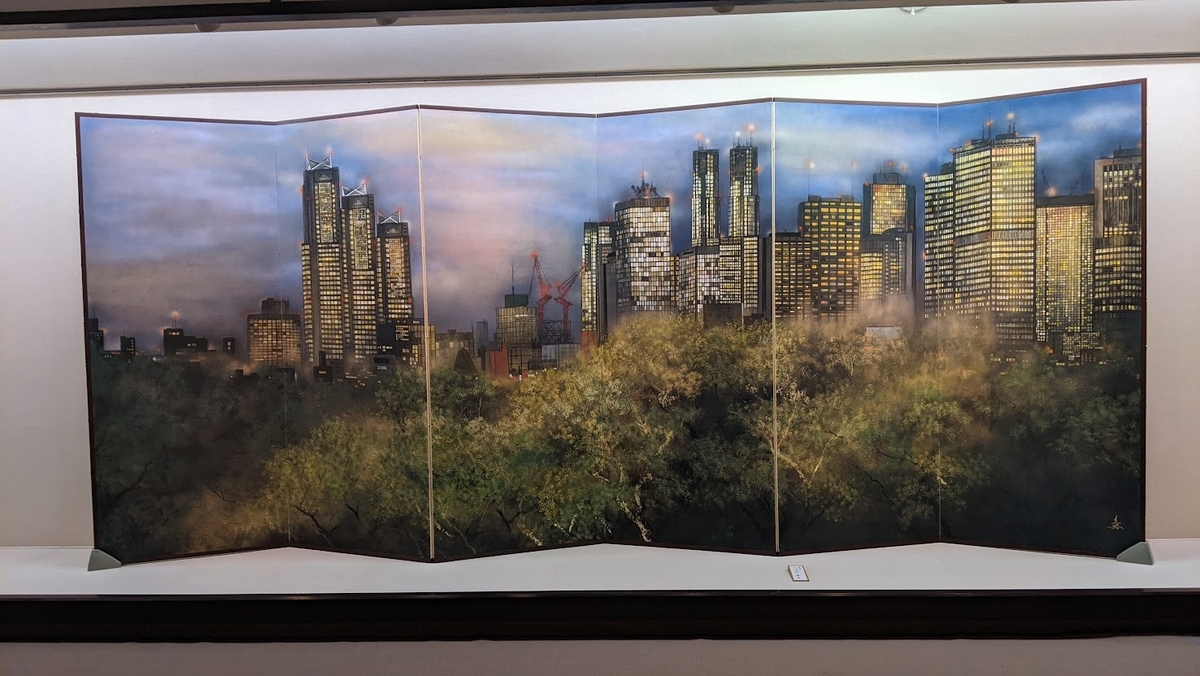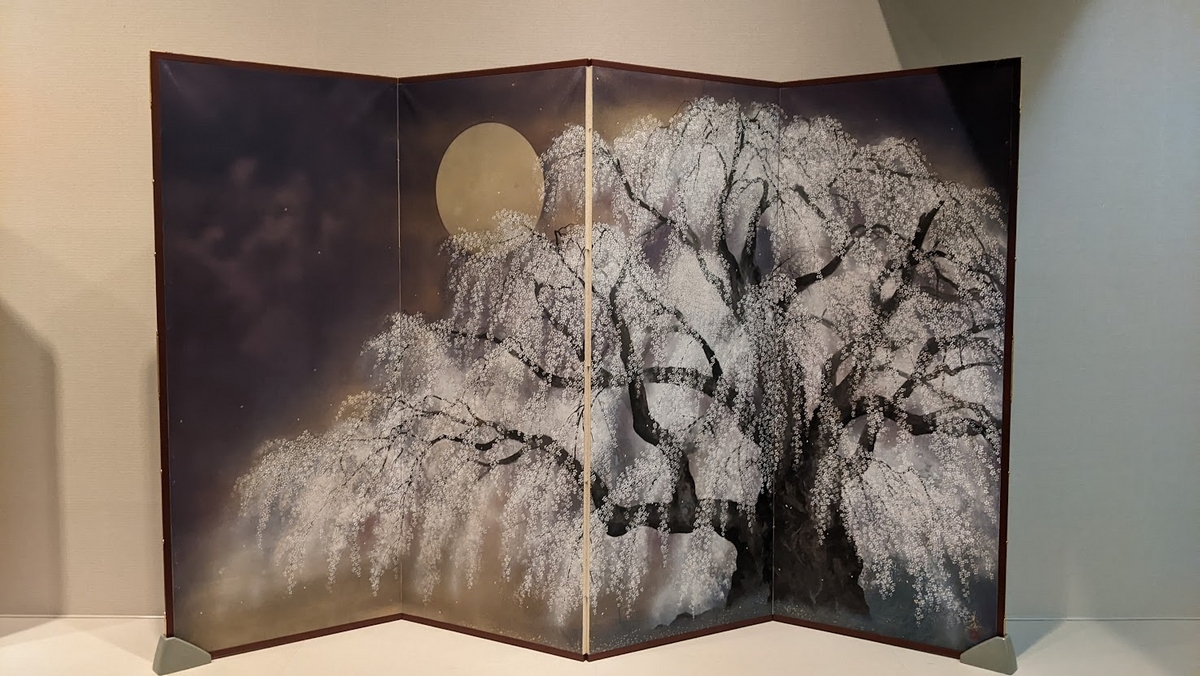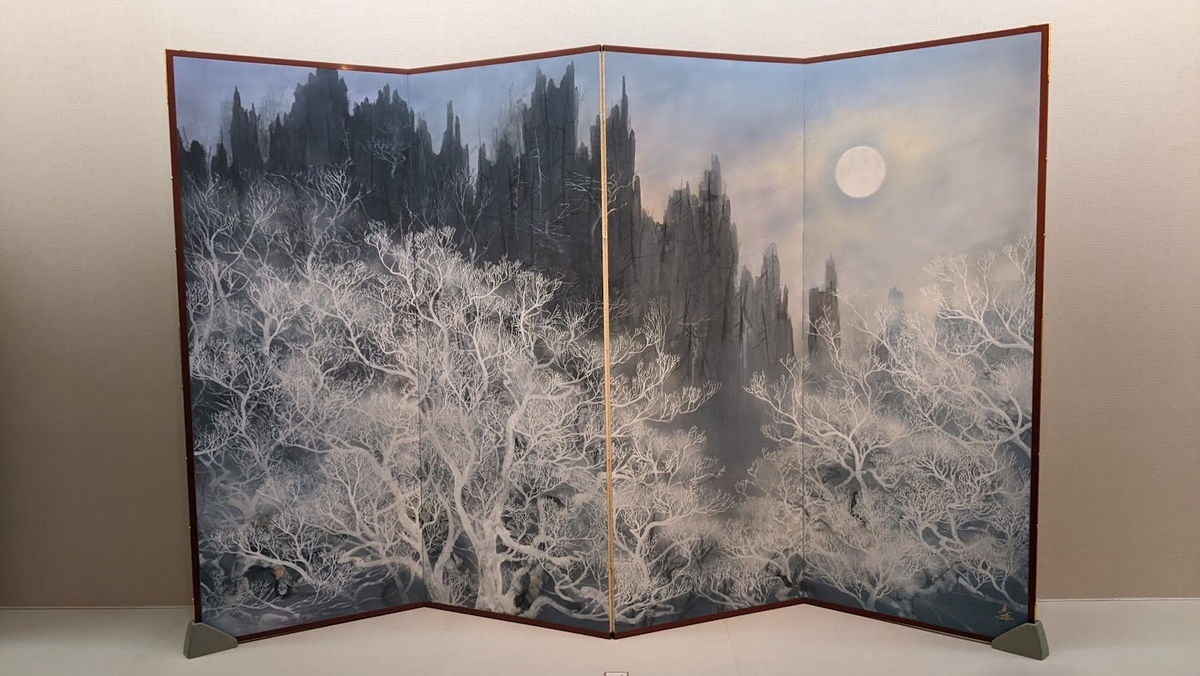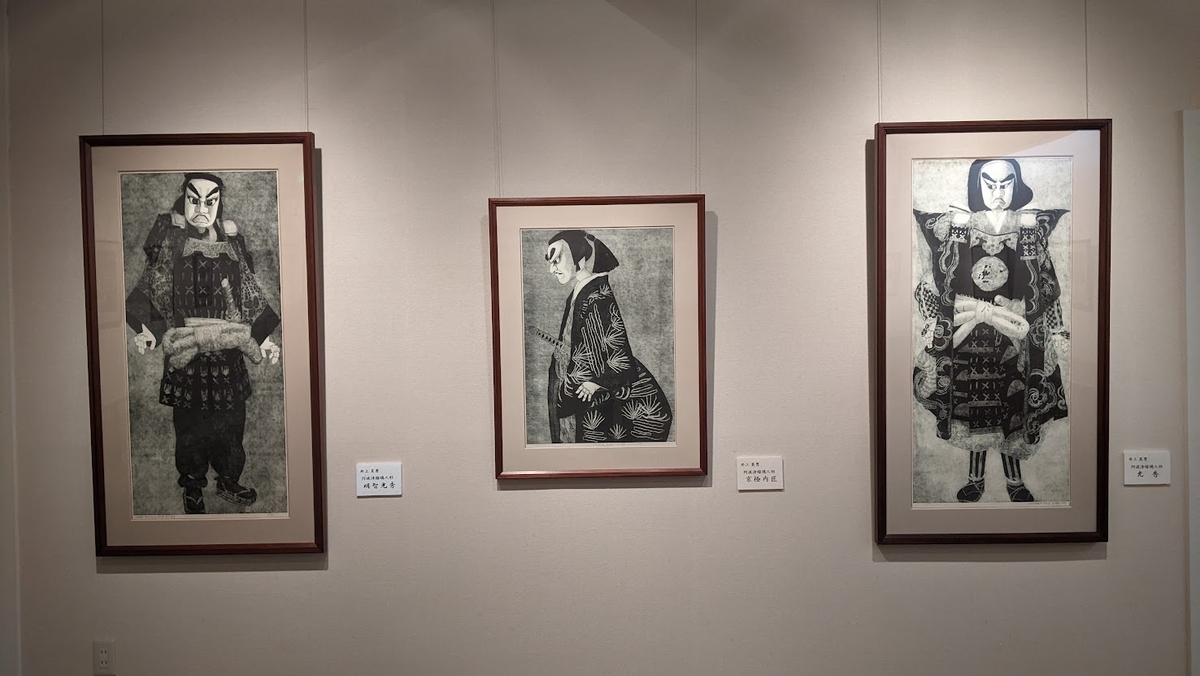京都滞在中に「承天閣美術館」を鑑賞!/ Through my stay in Kyoto, enjoyed seeing the Jotenkaku Museum, which houses works by Jakuchu Ito, Okyo Maruyama, and Tohaku Hasegawa!






■南禅寺を訪れた同日、夕刻からの空き時間を利用して、地下鉄烏丸線『今出川駅』の京都御所や同志社大学近くにある「相国寺」付属の承天閣美術館を訪れました。今回は、『禅寺に伝わるものがたり Ⅰ期:仏教説話と漢故事』が開催されていました。現在は、二期展示にあたり『女性と仏教』が5/28(日)~7/17(日)まで開催されています。相国寺は、明徳3年(1392)に夢窓疎石を開山とし、室町幕府第三代将軍足利義満によって創建された臨済宗相国寺派の大本山です。京都五山の第二位に位置し、絶海中津や横川景三と言う五山文学を代表する禅僧や、如拙・周文・雪舟らの日本水墨画の規範を築いた画僧を多く輩出、地理的にも文化的にもかつて京都の中心だったようです。
■知らなかった相国寺の歴史
相国寺は、実は、何度も火災に遭い、応仁の乱では、細川方の陣地になった理由で、殆ど伽藍を焼失したと言う事です。1584年(天正十二年)、九十二世住持となった西笑承兌は豊臣秀吉に重用され、1605年(慶長十年)には、豊臣秀頼の支援で多くの堂宇が再興されるなど復興が進んだようですが、複数の火災に遭い、1788年(天明八年)には、法堂以外の殆どの建物が焼失したと言う不運が続きます。明治に入って、“廃仏毀釈”の風潮や、寺領の減少で、苦境に立たされましたが、第百二十六世独園承珠の力で乗り越え、現在では、臨済宗相国時派の総本山として、100近い相国寺派の寺院を束ねているそうです。
約600年余の歴史を通して、相国寺や、金閣寺、銀閣寺を初めとする、塔頭に伝わる品々を収蔵する美術館で、主な所蔵品には、無学祖元墨蹟(国宝)、長谷川等伯筆竹林猿猴図屏風(重文)、伊藤若沖筆金閣寺大書院障壁画(重文)、吉山明兆筆春屋妙葩頂相(重文)等々、国宝5点、重要文化財145点と、中近世墨蹟・絵画・茶道具等多数の文化財を保有しているそうです。実は、相国寺も春の特別拝観の期間で<令和5年3/24(日)~6/4(日)午前10時から午後4時>で、法堂、方丈、浴室(四年ぶり公開)なども公開されていましたが、今回は時間がなく観覧できませんでしたが、また機会があれば訪れてみたい場所です。
こちらの寺院内にある美術館は、土足厳禁で、カーペット状の床を素足で歩いて観覧出来るので快適ですし、荷物も預ける事が出来る上、バリアフリーになっています。また、緑豊かな広々とした手入れの行き届いた美しい庭園を眺めながら、静かな環境の中で、落ち着いて美術品を鑑賞することができます。


















--------------------------------------------------------------------------------------
■Through my stay in Kyoto, enjoyed seeing the Jotenkaku Museum, which houses works by Jakuchu Ito, Okyo Maruyama, and Tohaku Hasegawa!
On the same day that I visited Nanzenji Temple, I utilized my free time from the evening to visit to the Jotenkaku Museum close to the Kyoto Imperial Palace at Imadegawa Station on the subway Karasuma Line which is attached to Shokokuji Temple just adjacent Doshisha University. This time, "Tales from Zen Temples Phase I: Buddhist Stories and Chinese Legends" was being held. At present, "Women and Buddhism" is also being held from 5/28 (Sun) to 7/17 (Sun) for the second exhibition. The Shokokuji Temple is the head temple of the Shokokuji School of Rinzai Buddhism, founded in 1392 by Soseki Muso and Yoshimitsu Ashikaga, the third shogun of the Muromachi Dictatorship. It is located in the second place of Kyoto Gozan, and it has produced many Zen priests such as Zekkai Nakatsu and Yokogawa Keizo, who are represent Gozan literature, and painter priests such as Josetsu, Shubun, and Sesshu who established the standard of Japanese ink painting. Geographically and culturally, it also used to be the center of Kyoto.
■The History of Shokokuji
In fact, Shokoku-ji was destroyed by fire many times, and in the Onin War, most of the temple was destroyed by fire because it became the base of the Hosokawa clan. In 1584 (Tensho 12), Jota Saisho, who became the 92nd Chief Priest, was appointed by Hideyoshi Toyotomi in 1605 (Keicho 10), many halls were rebuilt with the support of Hideyori Toyotomi. It seems that reconstruction has progressed, but it suffered from multiple fires and most of the buildings except the hall were destroyed by fire in 1788 (Tenmei 8). At the beginning of the Meiji era, the trend of 'abolition of Buddhism' and the decrease in the temple's territory put it in a difficult situation. With the power of the 126th Dokuen Shoju, it is now the head temple of the Shokoku-ji as School of Rinzai Buddhism and it has nearly 100 temples of the Shokoku-ji school. This museum houses works handed down to the sub-temples of Shokoku-ji, Kinkaku-ji, and Ginkaku-ji over a history of about 600 years. There are 5 National Treasures, 145 Important Cultural Properties, including 5 National Treasures. It seems that they have a large number of cultural assets such as 145 Important Cultural Properties, and Medieval and early modern calligraphy, paintings and tea tools.
In fact, Shokoku-ji Temple was also open for special spring visits <Sunday, March 24, 2023 to Sunday, June 4, 2020, from 10:00 am to 4:00 pm>, but this time I could not see it due to lack of time, but I would like to visit again if I have the opportunity. The museum inside this temple is forbidden to wear shoes, so we can walk barefoot on the carpeted floor, so it's very comfortable, we can leave our luggage, and it's also barrier-free. In addition, we can relax and appreciate the works of art in a quiet environment while gazing at the lush, spacious, and well-maintained garden!
京都滞在中に『南禅寺』へお参りに!/Visit to "Nanzenji" Temple during my stay in Kyoto!




■今月は、京都四条烏丸を日帰りで訪れる所要があり、その時間の前後の時間を利用して、早朝の静かな時間帯を狙って、松やモミジの緑の若葉の美しい南禅寺を訪れました。
・南禅寺の正称は『瑞龍山太平興国南禅禅寺「ずいりゅうざんたいへいこうこくなんぜんぜんじ」』と呼ばれ、臨済宗南禅寺派の大本山です。南禅寺で、最も有名な建造物が「三門」で、別名「天下龍門」とも呼ばれる南禅寺の三門は、「五鳳楼」と呼ばれる楼が美しく、日本三大門の1つと言われています。1295年に創立されましたが、火災で焼失し、今の三門は1628年に再建されたものの様です。今回、私は、上りませんでしたが、歴史的な古い急な階段を上って楼上へ行くと、22メートルの三門からは、高い建物がない京都市街を見渡すことが出来るようです。南禅寺三門は2階建てになっており、楼上内陣には、本尊宝冠釈迦座像「ほうかんしゃかざぞう」を主に、月蓋長者「がっかいちょうじゃ」、善財童士「ぜんざいどうじ」、十六羅僕「じゅうろくらぼく」と、本光国師、徳川家康、藤堂高虎の像が安置されています。 もう一つの大きな見所は、天井には鳳凰、天人の極彩色の図が描かれており、狩野探幽、土佐徳悦の作品と伝えられています。地上から、来訪者が三門楼上に登っているのが見えましたが、きっと京都市街の町並みや、初夏の緑豊かな南禅寺境内を見渡す事が出来るのだろうと想像しました。










・南禅寺の中心「法堂」は、三門をくぐり奥へ進むと、三門から法堂へと続く左右の道は、今頃は若葉が美しく、秋には絶景の紅葉が楽しめそうです。法堂は、南禅寺の中心となる建物で、公式の法要が開催される場所です。現在の法堂は、1909年に再建されたもので、1990年に開山大明国師700年大遠忌記念行事として屋根葺替工事と敷瓦取替工事が施されたようです。法堂には、本尊釈迦如来、文殊菩薩、普賢菩薩の三尊像が安置されていて、床は一面の敷瓦、天井には今尾景年の大作と言われる、見事な幡龍が描かれていて、写真のように法堂の柵の隙間から、内部が拝観出来ます。












・名勝庭園は、小堀遠州作と伝えられる枯山水庭園で、1951年に国指定の名勝となった「虎の子渡しの庭」と呼ばれる巨大な石を横に寝かして配置された庭です。
白砂の中に石や苔、手入れの行き届いた枯山水の庭で、江戸時代初期に近江小室藩初代藩主・小堀政一によって設計されたそうです。こちらの庭園は、鎌倉時代末期の代表的な池泉回遊式で、京都の三名勝史跡庭園の1つに指定されており、庭園にある池は上池と下池からなり、上池は竜の形を模しているとか。午前中の早い時間に、まだ人気のないこの池の周りを一周回りながら、美しい庭を観賞することが出来ました。







・「水路閣」は、南禅寺の見処となっていますが、今回も国内、海外の観光客の方々が写真映えする「水路閣」に、写真撮影に集まっていました。南禅院の目の前、南禅寺の境内にある水路閣で、琵琶湖から京都市内へと引かれた琵琶湖疏水の一部で1888年に完成したそうです。水路は明治23年に建造された南禅寺水路閣と呼ばれるレンガ造り、ローマ風のアーチ橋上を通っています。水路閣は全長が全長93.2m、幅4.06m、水路幅2.42mで、レンガ・花崗岩で造られたアーチ橋脚の構造物で景観に配慮して設計され、国および京都市指定の史跡となっているようです。こちらの水路閣は、今も琵琶湖の水が毎秒2tも流れているそうです。

・最後に、南禅寺の塔頭「天授庵」は、特に紅葉の季節には庭園の眺めが美しいことで有名なうえ、南禅寺を開山した無関普門の塔所として、暦応2年(1339)に光厳上皇の勅許により建立されました。池を中心に木々が茂る池泉回遊式庭園と、白砂を敷き詰めた庭に苔と菱形の畳石が配された枯山水庭園の2つの日本庭園が楽しめるそうです。今度は、時間の関係で拝観が出来なかったので、紅葉の時期の再訪を、南禅寺の湯豆腐と共に、楽しみに取っておきます!




------------------------------------------------------------------------------
Visit to "Nanzenji" Temple during my stay in Kyoto!
■Early this month, I had a day trip to "Shijo Karasuma" in Kyoto, so I utilized the free time before and after that time to visit Nanzenji Temple, which is beautiful with new green leaves of pine and maple, aiming for a quiet time in the early morning.
・The official name of Nanzenji is Zuiryusan Taiheikokoku Nanzenzenji and it is the head temple of the Nanzenji branch of the Rinzai group of Buddhism. Nanzenji Temple's most famous structure is the 'Sanmon', also known as 'Tenka Ryumon'. The Sanmon is said to be one of Japan's three great gates, with a beautiful tower called "Gohoro". It was founded in 1295, but it was destroyed in a fire and then the current Sanmon Gate appears to have been rebuilt in 1628. I didn't go up this time, but if we go up the historic old steep stairs to the top of the tower, it seems that we could overlook the city of Kyoto without tall buildings from the 22-meter Sanmon gate. Nanzenji Sanmon is a two-story building and in the inner sanctuary on the top floor. There are mainly the Gakkai Choja, Hokanshakazazo, the principal image of the crowned Shakyamuni Buddha, as well as the Gakka Ichoja, and Zenzai Doshi. The statues of Zenzaidouji, Jokukuraboku, Honko Kokushi, Tokugawa Ieyasu, and Todo Takatora are preserved here. Another major highlight is the richly colored paintings of phoenixes and spiritual beings on the ceiling, which are perceived to be the works of Tanyu Kano and Tokuetsu Tosa. From the ground, I could notice visitors climbing to the top of the Sanmonro, and I imagined that I would be able to see the cityscape of Kyoto city and the Nanzenji precincts, where were lush with greenery in early summer.
・At the center of Nanzen-ji Temple, there is "Hodo", if you pass through the Sanmon Gate and proceed to the back, the left and right roads leading from Sanmon to the Hodo Hall are beautiful young leaves at this time and we can enjoy the spectacular autumn leaves in autumn. The dharma hall is the central building of Nanzenji Temple and is the place where official memorial services are held. The current hall was rebuilt in 1909, and the roof was re-roofed and the floor tiles were replaced as part of the 700th anniversary of the death of Daimyo Kokushi in 1990. The ceiling was decorated by the masterpiece of Imao Keinen with a splendid dragon. The principal image of Shaka Nyorai, Monju Bosatsu, and Fugen Bosatsu are enshrined in the dharma hall. As we can see in the photos, we can glimpse the interior through the breach between the fences of the hall.
・The Meisho Garden is a “Karesansui” garden said to have been made by Kobori Enshu, and it was designated as a national scenic spot in 1951. It is a garden with huge stones lying sideways called "Toranoko Watashi no Niwa".About Stones and moss amidst white sand, this well-maintained dry landscape garden was designed in the early Edo period by Masakazu Kobori, the first lord of the Omi Komuro domain. This garden is a typical pond style of the end of the Kamakura period, and it has been designated as one of Kyoto's Three Scenic Beauty Historic Site Gardens. I was able to appreciate the beautiful garden while making a circuit around this still-unpopular pond in the early hours of the morning.
・"Suirokaku" is the highlight of Nanzenji Temple, and the tourists from Japan and overseas gathered at "Suirokaku" to take pictures this time as well. In front of Nanzen-in Temple, it is an aqueduct on the precincts of Nanzen-ji Temple. The waterway passes over a brick, Roman-style arch bridge called Nanzenji Suirokaku, which was built in 1890. Suirokaku has 93.2m long, 4.06m wide and the waterway has 2.42m wideth. It is an arch pier structure made of bricks and granite. There seems to be that 2 tons of water from Lake Biwa still flows through Suirokaku every second.
・Lastly, Nanzenji Temple's sub-temple, Tenjuan, is famous for its beautiful view of the garden, especially during the fall foliage season. It was erected by Imperial permission of the Retired Emperor Kogon in 1339. There are two Japanese gardens to enjoy, the Chisen Kaiyu-shiki garden with a pond and lush trees, and the Karesansui garden with white sand covered with moss and lozenge-shaped tatami stones. This time, I couldn't visit it due to time, so I'm looking forward to revisiting the autumn leaves season together with enjoying Nanzenji's boiled tofu!
新緑の禅寺「曹源寺」へ / Go to the Sogenji, a Zen Temple in the fresh greenery!





■岡山市中区円山にある曹源寺(そうげんじ・岡山県指定重要文化財)は、岡山藩池田家の菩提寺で、池田綱政が父光政と祖父信輝の菩提を弔うために、元禄11年(1698年)建立した臨済宗の禅寺です。初めに、正門を入ると100本の松並木が、寺院へ一本線に作られており、裏山の自然環境との調和の美しさが印象的です。曹源寺は、非常に静かで、四季折々の見事な花や紅葉が楽しめます。特徴的なのは、現在の修行僧は、全て海外から受入れておられる様で、外国から禅宗を学び集う人々に大変人気があるお寺です。日常、街の中でも、外国からの修行僧の方々も托鉢をされている姿に出逢うことも多いです。
建物群として、備前国第一の禅寺と称され、本堂は備前第一の大建築で、写真の通り、参道より総門・三門・仏殿が一直線上に配されています。仏殿に向かって右に鐘楼・左に鼓楼が配されており、鼓楼の奥(仏殿向かって左)に経蔵、経蔵の後に開山塔(開山堂)があります。仏殿向かって右には方丈があり、方丈奥に池泉回遊式庭園があります。庭園は、光政公の命を受けて、津田永忠によって作られ、池田家の墓地もあり、時が止まったかのような静けさと雰囲気が漂っています。
今回は、新緑の美しい季節に、広い庭園をゆっくりと散策出来ました。建物の内部には、自由に入ることは出来ませんでしたが、寺院からお務めの僧の方々の読経や、集まって走って居られる姿を拝見して、その雰囲気を感じるとることは出来ました。岡山県に観光の機会がある方は、市街地からも比較的近いので、観光に訪れるにも、素敵な禅寺です。










----------------------------------------------------------------------------------
Go to the Sogenji, a Zen Temple in the fresh greenery!
■The Sogenji Temple in Maruyama, Okayama City (Okayama Prefecture Designated Important Cultural Property) is the family temple of the Ikeda family of the Okayama Domain. (1698) It is a Zen temple of the Rinzai denomination. First, when we enter the main gate, 100 pine trees are built in a straight line to the temple, and the beauty of harmony with the natural environment of the mountain behind is very impressive. The Sogenji is very quiet, and we can enjoy beautiful flowers and autumn leaves in each season. It seems that all the current monks are accepted from overseas. Daily, even in the city, we often come across monks from foreign countries doing alms.
As a group of buildings, it is called the main hall is the number 1 large building in Bizen. Facing the Buddhist Hall, there is a bell tower on the right and a drum tower on the left. Also, opposite to the Buddhist Hall, there is the Hojo on the right and behind the Hojo, there is a pond garden. The garden was created by Nagatada Tsuda by the orders of Mitsumasa Ikeda and there is also the Ikeda family cemetery. This time, I was able to take a leisurely stroll through the large garden in the beautiful season of fresh green. We weren't allowed to enter the building freely, but we were able to get a sense of the atmosphere when we saw the monks on duty from the temple chanting sutras and running together in outside. For those who can go sightseeing in Okayama, it is relatively close to the city area, therefore I would like to recommend visiting to a wonderful Zen temple for sightseeing.
和氣町「藤公園」へ/ To Wake cho "Fuji (Wisteria)Park"


■ 今年の大型連休の初めは、岡山県和氣町にある、和氣町藤公園の「藤まつり」に訪れました。藤公園は、約7,000平方メートルの敷地に、幅7m、総延長500mの藤棚が置かれ、北は函館の藤、南は鹿児島県坊津の藤と全国46都道府県の著名な100種類以上の藤を集めていますが、沖縄県だけは、野生の藤が生息しないそうです。藤の花が見られ、その種類の多彩さでは、日本一の規模となる名所になっています。
和氣町と言えば、和氣清麻呂の誕生地で、1250年を記念して、昭和60年に藤公園が完成したそうで、和氣神社とも隣接しています。藤まつりは、ちょうど藤の花の見頃である4月下旬から5月上旬に開催されています。今年は、藤の花の咲く時期も例年より早かったようです。夜間は、ライトアップの時間も設けられ、連休中は、ステージや屋台の出展もあり、観光客や地元の人々で賑わっていました。全国の紫、ピンク、白などの鮮やかな藤の花が咲き乱れ、株式会社徳川のこいのぼりの産地でもあるため、鯉のぼりも、あちらこちらに風に泳いでいて風流でした!







■和氣清麻呂とは?
和氣清麻呂(わけの きよまろ)733~799年
奈良・平安初期の律令官人。 備前国藤野郡(現和氣町)の生まれ。
恵美押勝の乱に功をたて、称徳天皇の信任を得たが、「道鏡事件」で道鏡の陰謀を阻止したため、「別部穢麻呂」と改名され大隅国(現鹿児島)に流されました。光仁天皇の即位と共に赦されました。
清麻呂は、庶務に練達、古事に明るく「民部省例」20巻「和氏譜」を作成しています。また、土木技術に才があり、平安遷都にも造宮大夫として尽力しました。さらに故郷備前の国でも郡民の負担軽減や飢饉救済のために多くの業績を残しています。
















--------------------------------------------------------------------------------
■To Wakecho "Fuji Park"
At the beginning of golden week holidays in this year, I visited the "Fuji Festival" at Wake-cho Fuji Park in Wake, Okayama Prefecture. The Wisteria Park has a wisteria trellis with a width of 7m and a total length of 500m on a site of about 7,000 square meters. There are more than 100 kinds of wisteria from 46 prefectures in Japan, such as wisteria from Hakodate in the north and wisteria from Honshu in Kagoshima Prefecture in the south. I heard that wild wisteria don't live in Okinawa Prefecture. The Wisteria Flowers can be seen here and the wide variety of wisteria flowers has made it one of the largest tourist attractions in Japan.
Concerning Wake-cho, it is the birthplace of “Wake no Kiyomaro” and in commemoration of the 1250th anniversary, the wisteria park was completed in 1985. It is also adjacent to Wake-jinja Shrine. The wisteria festival is held from late April to early May every year when the wisteria flowers are in full bloom. This year, it seems that the wisteria flowers bloomed earlier than usual. At night, there was a time for lighting up during the consecutive holidays, then there also were stages and stalls and it was crowded with tourists and locals. I enjoyed vivid purple, pink, and white wisteria flowers all over the country were in full bloom. In addition, Tokugawa Koinobori Co., Ltd. is also a production area for carp streamers, so the carp streamers were swimming here and there in the wind, which was so elegant!
■ Who is Wake no Kiyomaro ( 733-799) ?
Ritsuryo official in Nara and the early Heian period. Born in Fujino County, Bizen Province (now Wake Town).He was successful in the Rebellion of Emi no Oshikatsu and gained the trust of Emperor Shotoku, but because he thwarted Dokyo's plot in the 'Dokyo Incident', he was renamed 'Betsube no Okumaro' and exiled to Osumi Province (now Kagoshima). iHe was pardoned with the enthronement of Emperor Konin.Kiyomaro was proficient in general affairs and was well-versed in ancient affairs and created the 20th volume "Yamato Uji Fu" of "Public Ministry’s Rules ". In addition, he was talented in civil engineering and worked hard as a shrine building specialist for the transfer of the capital to Heian. Furthermore, in his hometown of Bizen, he has made many achievements in reducing the burden on the citizens of the county and in relieving famine.
国立西洋美術館 『憧憬の地 ブルターニュ・モネ、ゴーギャン、黒田清輝らが見た異郷』を鑑賞!/At the National Museum of Western Art in Tokyo, Admiring "Bretagne, the Land of Admiration - Overseas Country Senary by Monet, Gauguin, Seiki Kuroda, and Others"!





■上野恩賜公園の桜が咲き始めた小春日和の中、国立西洋美術館へ、現在2023年3月18日(土)~6月11日(日)開催している企画展に行ってきました。
フランス北西端のブルターニュ地方は、19世紀後半から20世紀初頭にかけ、ポスト印象派で著名なフランス画家を初め、同世代の多数の画家が訪れて、作品に鮮やかな景勝地や、その土地の人々の暮らしの様子や、背景を描いていました。
本展は、国立西洋美術館の「松方コレクション」を柱にして、複数の国内所蔵先と海外コレクション,例えば、町田市立国際版画美術館、京都工芸繊維大学美術工芸資料館、ポーラ美術館、東京文化研究所、東京国立近代美術館、大原美術館等々国内30ヵ所の美術館、や個人蔵、海外からは、オルセー美術館からと、多岐に渡る所蔵が同じテーマに沿って集結し、「ブルターニュ」を題材とした、風景や、文化、歴史を映す作品群160点が展示されていました。
最も、今展覧会で注目したのは、ポール・ゴーギャンの作品12点、クロード・モネや、アルフォンス・ミュシャ、ポール・シニャック、エミール・ベルナール,ポール・セリュジエ、アンリ・リヴィエール、モーリス・ドニ、シャルル・コッテ、リュシアン・シモン、アンドレ・ドーシェの作品群や、明治後期から大正初期に渡仏した黒田清輝、藤田嗣治、久米佳一郎、金山平三、斎藤豊作、満谷国四郎、小杉未醒、森田恒友、黒田重太郎等の日本人近代画家の描いたブルターニュや、フランス各地の景勝地や人々の様子の描写も見応えがありました。今から100年以上前に、画家たちの渡航に愛用した時代を感じる古びたスーツケースが幾つか展示されていましたが、その頃、長い船旅を経て、スーツケース一つで、西洋に渡り、自らの経験を積み、芸術を創造し、開花させる一心で、異国に赴いた日本人画家たちを想像すると、当時の日本と全く違う情景や、背景に込めた思いの各作品が、より鮮明に印象に残りました。










■ブルターニュ地方について
フランス北西部ブルターニュは、昔は、ブルターニュ公国として独立していたこの地は、ブルトン文化が息づく異国情緒溢れる地域です。花崗岩からなる石造りの民家や、木組みの民家が多く存在し、深い藍色に輝く屋根に覆われています。1年を通して、雨の日が多い地域ですが、濡れた石畳がオレンジ色の街灯に照らされる光景は何とも風情があると言います。国内外の画家たちが、この地に憧れて赴いたのが判ります。
個人的には、ブルターニュと言えば、そば粉のクレープ、クイニーアマンや、ゲロンドの塩(Sal de Guérande)、タラソテラピーの本場として思い浮かびます。以前、タラソテラピーでタラソドブルターニュの製品を愛用していたことがあります。今もゲロンドの塩はとても美味で利用しています!













-----------------------------------------------------------------------------
■At the National Museum of Western Art in Tokyo, Admiring "Bretagne, the Land of Admiration - Overseas Country Senary by Monet, Gauguin, Seiki Kuroda, and Others"!
I visited to the National Museum of Western Art to see the special exhibition currently being held from Saturday, March 18, 2023 to Sunday, June 11, 2023. From the late 19th century to the early 20th century, the Bretagne region on the northwestern edge of France was visited by many painters of the same generation, including the famous post-impressionist French painter who drew beautiful the scenes and the backgrounds. With the Matsukata Collection of the National Museum of Western Art as its support, this exhibition presents works from multiple assemblies, such as the Machida City Museum of Graphic Arts, Kyoto Institute of Technology of Museum of Art and Crafts, Pola Museum of Art, Tokyo Bunka Research Institute, the National Museum of Modern Art, the Ohara Museum of Art and other over 20 art museums in Japan as well as private collections, and from overseas, the Musée d'Orsay. Therefore, 160 works reflecting culture and history are exhibited now.
Most notable in this exhibition were the 12 works by Paul Gauguin and masterpieces of Claude Monet, Alphonse Mucha, Paul Signac, Emile Bernard, Paul Sérusier, Henri Riviere, Maurice Denis, and Charles Cottet. , Lucien Simon, and André Daucher, Moreover, there were astonishing drawings of Japanese artists who traveled to France in the late Meiji and early Taisho periods.such as Seiki Kuroda, Tsuguharu Fujita, Keiichiro Kume, Heizo Kanayama, Hosaku Saito, Kunishiro Mitsutani, Misei Kosugi, Tsunetomo Morita, and Jutaro Kuroda. These drawings of Bretagne and French scenic spots were also worth seeing. Over 100 years ago, there were several old suitcases on display in the exhibition that were used by Japanese painters to travel abroad. Especially once I could imagine Japanese painters traveling to the West with only one suitcase by a long sea voyage, for just accumulating their own experience, creating thier own art and devoting themselves to flowering at that time, each work with different scenes and backgrounds left a more vivid impression a lot.
■Regarding the Bretagne Region
Bretagne region is located in northwestern of France.Once independent as the Duchy of Bretagne, this area seems to be an exotic area where Breton culture is still alive. There are many private houses made of granite stone and half-timbered houses, covered with deep indigo blue roofs. It rains a lot throughout the year, but the sight of the wet cobblestones illuminated by the orange streetlights is said to be very atmospheric. Painters from Japan and abroad longed for this place with their beautiful natural scenic spot.
For me personally, when I imagine Bretagne, I think of buckwheat crepes and Kouign-Amann, the Guérande salt and the home of thalassotherapy. In the past, I used Thalasso de Bretagne's products for thalassotherapy, and I still use Gueronde's salt because it is very delicious.
“木村圭吾の世界展 咲き匂う桜たち” 展示会へ! /Keigo Kimura's World Exhibition “Blooming Cherry Blossoms" !






■白壁造りの御屋敷と森に囲まれた静かな東京練馬区にある、光が丘美術館に、春期 1月7日(土)~3月26日(日) の展示に変わっていたので、訪れてみました。付近の森には、ちょうど木蓮や椿が咲き、金柑などもなっていて、暖かい天候のなかゆっくりと観覧も出来ました。今回はいずれも伝統的な日本画の木村圭吾氏のサクラをモチーフにした絵画を中心に、井上員男氏紙版画や、田中良忠氏「貝合わせ」なども展示がありました。美術館所蔵の木彫の釈迦如来像も立派でした。













■木村圭吾氏 略歴:
1944年 京都府生まれ
1963年 京都市立日吉ヶ丘高等学校日本画科卒業(旧京都市立美術工芸学校)
1974年 シェル美術賞展佳作賞受賞
1985年 第8回山種美術館賞展招待出品(第9回・第12回)
1993年 「両洋の眼展」出品(以降毎年)
1996年 第3回倉吉博物館菅楯彦大賞展市民賞受賞
1997年 「鐘韻燦花一遥かなる旅路一木村圭吾日本画集」(毎日新聞社)出版
1999年 NHK大河ドラマ「元禄繚乱」装画・個展(箱根・芦ノ湖成川美術館)増上寺天井絵 奉納
2001年 法樂寺障壁画完成。
「法樂寺障壁画完成記念展一木村圭吾 日本画の世界」(大阪)
「森羅万象一ほとばしる生命 木村圭吾 日本画の世界」(淡交社刊)出版
2002年 薬師寺に散華奉納
そごう横浜店「桜花紀行 木村圭吾日本画展」
2006年 5月5日、「老桜その命」(NHK総合)で、木村圭吾の作品と「山高神代桜」が放映
フランス カンヌ市・静岡市姉妹都市15周年記念特別展「天と地 日本画家木村圭
吾の世界展千年桜と聖龍」 (フランス カンヌ市・エスパス・ミラマール)
2007年 シルク・ドゥ・ソレイユ「ドラリオン」スペシャルサポーター参加
月歌会始御題に寄せて-(神宮美術館)に「月下の宴」を出品
「木村圭吾さくら美術館」さくら讃歌展
「天と地 千年桜と聖龍」凱旋帰国特別展(静岡)
「天と地 悠久の花舞台」(船橋)
「天と地 千年桜と聖龍木村圭吾日本画展」(そごう横浜店)
2008年 「悠久の花舞台」個展(大阪)
「千年桜と四季万象の世界」個展(仙台)
2009年 アートホール完成
倉吉トリエンナーレ美術賞回顧展 「両洋の眼展」20回展「龍の起源」出展
2010年 四季回廊・悠久の花舞台一木村圭吾日本画の世界展
2011年 光の回廊一木村圭吾展各地巡回
「煌めく大地」木村圭吾日本画の世界展(そごう横浜店)
「煌めく大地」木村圭吾日本画の世界展(近鉄百貨店 阿倍野店)
2013年 木村圭吾展各地巡回
2018年 「美の宇宙(アートのコスモス)」木村圭吾画業50周年記念展(平野美術館)
■井上員男氏 略歴:
1932年香川県生れ 香川大学教育学部美術科卒
1988年在仏日本大使館主催ユネスコ日本週間展覧会に招待出品
2006年ペーパー・ドライポイント特許取得 文芸誌「アルプ」の同人としても活躍した
■田中良忠氏 略歴:
・1985年 - 東京の銀座松屋にて初個展、以後 39回の個展開催。主な個展画廊、横浜高島
・新宿高島屋、玉川高島屋、(四国)松山高島屋、(浜松)遠鉄百貨店、(麹町) 裏千家会
館、(虎の門)寿泉堂画廊、
・(岡山)天満屋本店 (京都)瀬戸内寂聴先生所有の町屋(羅紗庵)にて4年連続、4回
の個展を開催。
・ニューヨーク 日本クラブにて2度の個展を開催。
・作品所蔵美術館:1987年、金沢市金箔工芸館。「源氏物語」
・1994年、東京練馬区、光が丘美術館。「平家物語」 「花鳥風月12か月」を納入。
・1989年 - 外務省から派遣され、アメリカのシアトルとニューオリンズの州立美術館にて
講演および個展を開催。
・2000年、2006年 - NHK「世界ハート展」2度作画出品。
・2012年4月 ニューヨーク The Nippon Gallery at The Nippon Club(日本クラブ)にて
展覧会開催
・2015年9月 第二回、ニューヨーク展、日本クラブにて開催







-----------------------------------------------------------------------------------
Keigo Kimura's World Exhibition “Blooming Cherry Blossoms Exhibits"
■ I visited the Hikarigaoka Museum of Art, which is located in a quiet residential area in Nerima-ku of Tokyo surrounded by white-walled mansions and forests. The art exhibition had changed to a spring exhibition from January 7th to March 26th in 2023. In the nearby forest, magnolias and camellias were just blooming and kumquats were growing too. This time, the exhibition focused on traditional Japanese paintings as main motif of Cherry Blossoms by Mr. Keigo Kimura as well as paper prints by Mr. Kazuo Inoue and Mr. Yoshitada Tanaka's "Kaiawase".
At the same time, the wooden statue of Shaka Nyorai “Budda” owned by the museum was also splendid.
イタリア建築家ガエ・アウレンティ展示会とドメニコ・ノルディオ ヴァイオリン・リサイタルへ/ Enjoy Italian architect, Gae Aulenti ‘ s Exhibition & Domenico Nordio’s Violin Recital



■先日、東京都九段にある1959年よりあるイタリア文化会館へ、2005年に新たに竣工した当建築の設計を担当した「ガエ・アウレンティの展示会」と、イタリアからの「ヴァイオリンニスト、ドメニコ・ノルディオ氏 リサイタル」へ行って来ました。当会館は、イタリア外務省機関で、世界88のイタリア文化会館のひとつで、イタリア文化普及と、日伊文化交流振興を目的に運営されています。今回リサイタルのあったホールは、372名を収容し、幅広い文化催事設備となっています。こちらでは、随時コンサート、映画、講演、展覧会などの開催や、イタリア語講座、イタリア専門図書室なども一般に開放しているようです。現地に行くには、九段下駅より徒歩10分程で、桜の名所の千鳥ヶ淵、九段会館、武道館、靖国神社を通って行けます。
今回初めて、ドメニコ・ノルディオさんの演奏をお聴きしましたが、世界中での演奏経験を積み重ねられ、熟練の力強く繊細な、今迄に聞いたことのない、現代的なヴァイオリン楽曲も楽しむことが出来ました。 普段の仕事の後に、こうした素敵な場所で、ライブを聴くのは久しぶりで、心身ともリフレッシュして有意義な時間が過ごせました!
以下ご参考に、ノルディオさんの演奏を見付けました。
■Domenico Nordio’s Bach , Accademia Musicale












■ヴァイオリン:ドメニコ・ノルディオ氏
ピアノ:三澤志保氏
プログラム
ルイジ・ダッラピッコラ(1904-1975)
タルティニアーナ 第2番(1955-56)
クロード・ドビュッシー(1862-1918)
ヴァイオリン・ソナタ(1916)
フェッルッチョ・ブゾーニ(1866-1924)
ヴァイオリン・ソナタ第2番(1898)







-----------------------------------------------------------------------------
■Enjoy Italian architect, Gae Aulenti ‘ s Exhibition and Domenico Nordio’s Violin Recital
The other day, I visited at the Italian Cultural Institute in Kudan in Tokyo, which has been in place since 1959. I went to enjoy the "Exhibition of Gae Aulenti", who was in charge of the design of this newly completed building in 2005 as well as the mini concert of Violinist Domenico Nordio from Italy. This hall is an institution of the Italian Ministry of Foreign Affairs and is one of the 88 Italian Cultu ral Centers in the world. It is operated for the purpose of spreading Italian culture and promoting cultural exchange between Japan and Italy. The hall, where the recital was held this time, accommodates 372 seats and serves as a facility for a wide range of cultural events. In our cultural center, concerts, movies, lectures, exhibitions are held from time to time and Italian language courses, Italian specialized library are also open to the public.
This was my first time listening to Domenico Nordio's performance. I was able to enjoy listening to many contemporary violin pieces that are skillful, powerful, delicate at this time, through his extended experience of performing all over the world. It's been a long time since I listened to a live performance in such a wonderful place after my usual work. So, I was able to spend a wonderful time refreshing my mind! !
To reach to this site, it takes about 10 minutes on foot from Kudanshita Station and we can go through Chidorigafuchi of a famous cherry blossom spot, Kudan Kaikan, Budokan and Yasukuni Shrine.
Violin: Mr. Domenico Nordio Piano: Ms. Shiho Misawa
*Program
Luigi Dallapiccola (1904-1975)
Tartiniana No. 2 (1955-56)
Claude Debussy (1862-1918)
Violin Sonata (1916)
Ferruccio Busoni (1866-1924)
Violin Sonata No. 2 (1898)